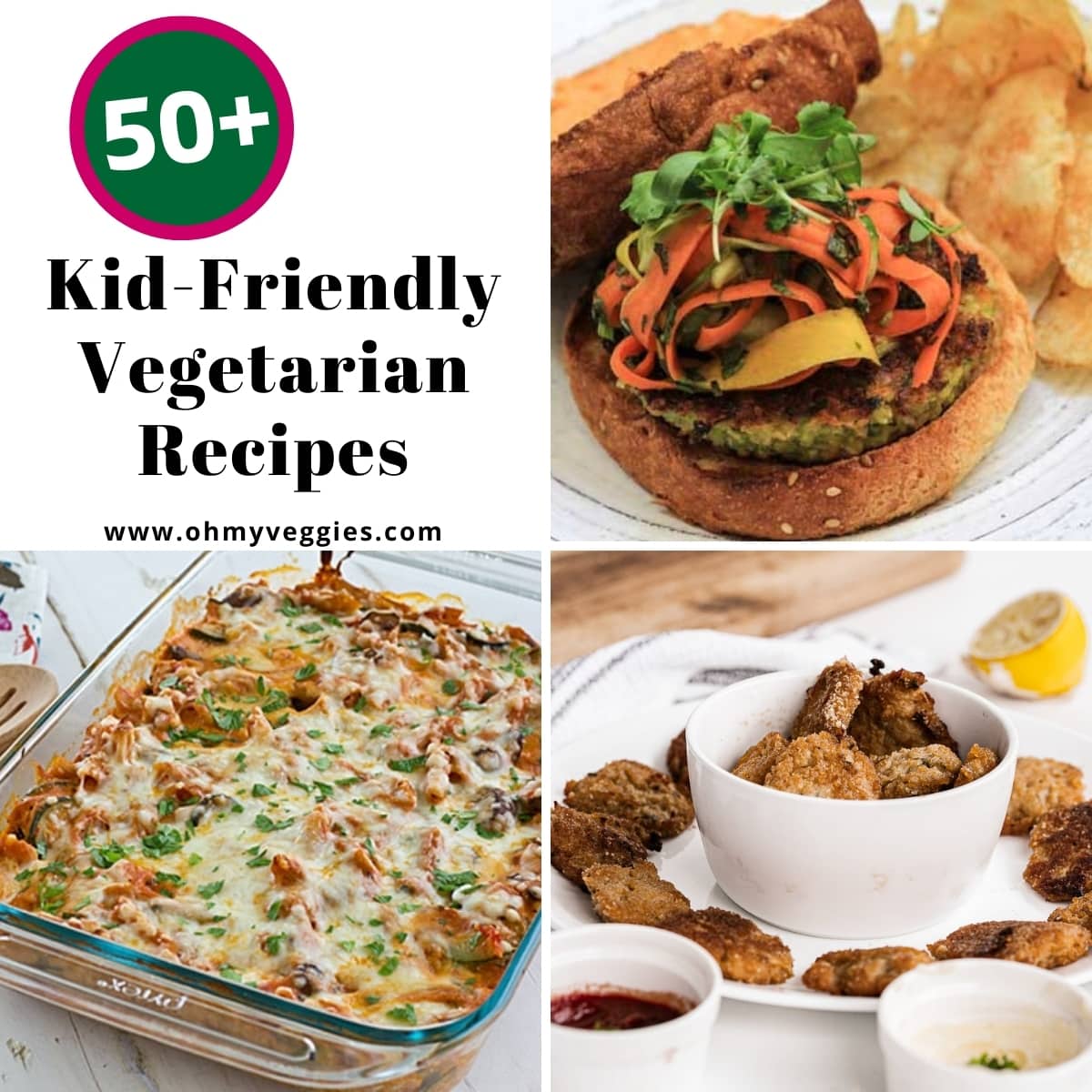Unleash your inner chef and embark on a culinary adventure with this collection of vibrant, kid-friendly vegetarian recipes! Forget bland veggies and picky eaters – we’re diving into a world of playful presentations and exciting flavors designed to make healthy eating a joyful experience for the whole family. From colorful pasta creations to veggie burgers bursting with goodness, these recipes are as easy to prepare as they are delicious to devour. Get ready to transform mealtimes into fun-filled feasts, where even the most reluctant vegetable eaters will happily reach for seconds.
This guide is packed with step-by-step instructions, creative serving suggestions, and nutritional information to ensure you’re equipped to create healthy and exciting vegetarian meals for your children. We’ll explore ways to subtly incorporate veggies into familiar favorites, address picky eating habits, and adapt recipes for different ages and dietary needs. Prepare to discover a treasure trove of delicious and nutritious recipes that will not only nourish your children’s bodies but also inspire a lifelong love of vegetarian cuisine.
Kid-Friendly Vegetarian Recipe Ideas

Getting kids to eat their veggies can sometimes feel like a marathon, not a sprint! But with a little creativity and the right recipes, you can transform healthy eating into a fun adventure. These recipes focus on simple preparation, vibrant colors, and delicious flavors to encourage even the pickiest eaters to explore the wonderful world of vegetarian cuisine.
Five Fun and Tasty Vegetarian Recipes
These five recipes are designed for ease of preparation, making them perfect for busy weeknights or fun weekend cooking projects. Each recipe emphasizes fresh ingredients and simple techniques, ensuring a quick and enjoyable cooking experience for both parents and children.
- Rainbow Veggie Skewers: Imagine colorful skewers bursting with cherry tomatoes, cucumber chunks, bell pepper squares (red, yellow, and orange!), and cubes of cheese. A simple balsamic glaze adds a touch of sweetness and tang. Kids can help assemble these, making it a fun and interactive activity.
- Mini Veggie Fritters: These golden-brown delights are made with grated zucchini, carrots, and corn, bound together with a little flour and egg (or flax egg for a vegan option). Serve with a dollop of plain yogurt or a light tomato salsa for dipping.
- Black Bean Burgers: Mashing black beans with breadcrumbs, spices, and a little chopped onion creates a surprisingly hearty and flavorful burger. These can be pan-fried or baked, and served on whole-wheat buns with your child’s favorite toppings.
- Pasta Primavera: A classic, easily customizable dish! Cook pasta according to package directions. Then, toss it with a medley of steamed or sautéed seasonal vegetables like broccoli florets, peas, asparagus spears, and sliced mushrooms. A light lemon-herb dressing ties it all together.
- Cheese Quesadillas: A quick and easy crowd-pleaser. Spread refried beans and shredded cheese between two whole-wheat tortillas. Cook in a pan until the cheese is melted and the tortillas are golden brown. Cut into triangles for easy handling.
Three Recipes with Colorful Vegetables
Color is key to making vegetarian dishes appealing to children. These recipes use a vibrant array of vegetables to create visually stunning and delicious meals. The bright colors not only enhance the aesthetic appeal but also signal the presence of essential vitamins and nutrients.
- Rainbow Veggie Skewers (as described above): The vibrant colors of the tomatoes, cucumbers, and bell peppers make these skewers irresistible.
- Caprese Salad Skewers: Simple, yet elegant. Cherry tomatoes, fresh mozzarella balls (or vegan mozzarella), and basil leaves are threaded onto skewers, drizzled with balsamic glaze. The red, white, and green combination is visually striking.
- Roasted Sweet Potato and Broccoli Bites: Cubed sweet potatoes and broccoli florets are tossed with olive oil, herbs, and spices before being roasted until tender. The sweet potatoes offer a beautiful orange hue, contrasting nicely with the deep green of the broccoli.
Vegetarian Pizza Recipe
This recipe uses a whole-wheat crust for added fiber and healthy toppings for maximum nutrition. The process of creating the pizza itself is a fun activity kids can participate in, fostering a sense of accomplishment and encouraging healthy eating habits.
Whole-wheat pizza crust (store-bought or homemade), tomato sauce, mozzarella cheese (or vegan alternative), mushrooms, bell peppers (various colors), onions, spinach.
Instructions: Spread tomato sauce over the crust. Arrange the vegetables and cheese in a visually appealing pattern. Bake until the crust is golden brown and the cheese is melted and bubbly. Consider adding a sprinkle of oregano or basil for extra flavor.
Veggie Burger Recipe
These veggie burgers are packed with flavor and nutrients, making them a healthy and satisfying alternative to traditional beef burgers. The recipe is designed to be adaptable, allowing you to use your child’s favorite vegetables and spices.
1 can (15 ounces) black beans, rinsed and drained; ½ cup cooked brown rice; ½ cup chopped carrots; ¼ cup chopped onion; 1 egg (or flax egg); ½ cup breadcrumbs; 1 tablespoon chili powder; ½ teaspoon cumin; Salt and pepper to taste.
Instructions: Mash the black beans. Combine all ingredients in a bowl and mix well. Form into patties. Cook in a pan with a little olive oil until browned on both sides. Serve on whole-wheat buns with your favorite toppings.
Step-by-Step Recipes
This section provides detailed, easy-to-follow instructions for creating delicious and kid-friendly vegetarian meals. Each recipe is designed to be fun and engaging for young cooks, encouraging them to explore the world of vegetarian cuisine. We’ll focus on simple techniques and readily available ingredients, making these recipes perfect for busy weeknights or fun weekend cooking projects.
Rainbow Veggie Pasta
This vibrant pasta dish is packed with colorful vegetables and is sure to be a hit with kids. The simple steps make it a great recipe for involving children in the cooking process.
Before you begin, gather all your ingredients and ensure your little helpers are ready to assist!
| Ingredient | Quantity |
|---|---|
| Pasta (penne, rotini, or your favorite shape) | 1 cup (dry) |
| Cherry tomatoes, halved | 1 cup |
| Zucchini, diced | 1/2 cup |
| Bell pepper (any color), diced | 1/2 cup |
| Broccoli florets | 1/2 cup |
| Olive oil | 2 tablespoons |
| Salt and pepper | To taste |
| Parmesan cheese (optional) | For grating |
- Cook the pasta according to package directions until al dente. Drain and set aside.
- While the pasta cooks, heat the olive oil in a large skillet over medium heat. Add the zucchini and bell pepper and cook for 3-4 minutes, until slightly softened.
- Add the cherry tomatoes and broccoli florets. Cook for another 2-3 minutes, until the vegetables are tender-crisp.
- Add the cooked pasta to the skillet and toss to combine with the vegetables.
- Season with salt and pepper to taste. Serve immediately, with grated Parmesan cheese if desired.
Tropical Delight Fruit Salad
This fruit salad is a feast for the eyes and the palate. Its vibrant colors and refreshing flavors make it a perfect healthy treat. The creative presentation adds an extra layer of fun for kids.
Remember to wash all the fruits thoroughly before starting. Involving kids in the washing and chopping (with supervision, of course!) adds to the fun.
- Select a variety of colorful fruits such as strawberries, blueberries, kiwi, mango, pineapple, and oranges. Consider using cookie cutters to make fun shapes.
- Cut the fruits into bite-sized pieces. For younger children, you might want to pre-cut the fruits to ensure safety.
- Gently toss the fruits together in a large bowl. You can add a squeeze of lime or a sprinkle of sugar if desired, but the natural sweetness of the fruits is usually enough.
- For presentation, arrange the fruit salad in a fun way. You could layer the fruits in a clear glass bowl to showcase their vibrant colors, or use cookie cutters to create fun shapes.
- Alternatively, create a fruit “pizza” by arranging the fruit on a large platter or cookie in a decorative pattern.
Quick and Easy Vegetable Soup
This simple soup is a nutritious and satisfying meal. Its quick preparation time makes it ideal for busy weeknights. The customizable nature allows you to add your child’s favorite vegetables.
This recipe is easily adaptable to what you have on hand. Feel free to substitute vegetables based on your preferences and what’s in season.
| Ingredient | Quantity | Ingredient | Quantity |
|---|---|---|---|
| Vegetable broth | 4 cups | Carrots, diced | 1 cup |
| Potatoes, diced | 1 cup | Celery, diced | 1/2 cup |
| Onions, chopped | 1/2 cup | Frozen peas | 1/2 cup |
| Salt and pepper | To taste | Fresh herbs (parsley, thyme) | 1 tablespoon |
- In a large pot, heat the vegetable broth over medium heat.
- Add the onions, carrots, and celery. Cook for 5-7 minutes, until softened.
- Add the potatoes and cook for another 10-12 minutes, until tender.
- Stir in the frozen peas and fresh herbs. Cook for 2-3 minutes, until heated through.
- Season with salt and pepper to taste. Serve hot.
Homemade Veggie Nuggets
These crispy and flavorful veggie nuggets are a fun and healthy alternative to traditional chicken nuggets. The homemade version allows for control over ingredients and ensures a healthier option.
These nuggets are best served immediately after baking for optimal crispiness. Feel free to experiment with different vegetable combinations to find your family’s favorites.
| Ingredient | Quantity |
|---|---|
| Cauliflower, finely grated | 2 cups |
| Carrots, finely grated | 1 cup |
| Breadcrumbs | 1 cup |
| Egg, lightly beaten | 1 |
| Spices (garlic powder, onion powder, paprika) | To taste |
| Olive oil | For brushing |
- Preheat oven to 400°F (200°C).
- In a large bowl, combine the grated cauliflower, carrots, breadcrumbs, egg, and spices. Mix well to combine.
- Shape the mixture into small nugget shapes.
- Lightly brush the nuggets with olive oil.
- Bake for 20-25 minutes, or until golden brown and crispy.
Adapting Recipes for Different Age Groups and Dietary Needs
Creating delicious and nutritious vegetarian meals for children requires careful consideration of their developmental stages and individual dietary needs. Adjusting recipes to accommodate different age groups and potential allergies ensures that every child can enjoy a healthy and satisfying vegetarian diet. This section will guide you through adapting recipes for toddlers, preschoolers, school-aged children, and children with specific dietary needs.
Recipe Modifications for Different Age Groups
Toddlers, preschoolers, and school-aged children have varying nutritional requirements and chewing abilities. Recipes need to be adjusted accordingly to ensure safe and enjoyable eating experiences. For toddlers, focus on soft, easily digestible textures. Purees or finely mashed foods are ideal. As children grow, introduce more varied textures and chunkier pieces. Preschoolers can handle small, soft pieces, while school-aged children can manage most adult-textured foods.
- Toddlers (1-3 years): Steamed and pureed vegetables, soft lentil soups, well-cooked pasta with creamy sauces (avoid added salt and sugar).
- Preschoolers (3-5 years): Mini veggie fritters, simple pasta salads with soft vegetables, cheese quesadillas (ensure cheese is cut into small, manageable pieces).
- School-aged children (6-12 years): Vegetarian chili, veggie burgers, pizzas with various toppings, stir-fries with a variety of colorful vegetables.
Adapting Recipes for Allergies and Intolerances
Many children have food allergies or intolerances, requiring careful recipe modifications. Common examples include dairy, gluten, and soy allergies. Substituting ingredients is crucial to ensure the child’s safety and nutritional needs are met. Always carefully read labels and check for potential cross-contamination.
- Dairy-free: Replace dairy milk with plant-based alternatives like almond, soy (if no soy allergy), oat, or rice milk. Use dairy-free cheeses and yogurts. For creamy sauces, use cashew cream or silken tofu.
- Gluten-free: Use gluten-free flour blends in baking. Opt for gluten-free pasta, bread, and crackers. Ensure that all ingredients, including sauces and seasonings, are gluten-free.
- Soy-free: Avoid soy-based products like soy milk, tofu, and soy sauce. Use alternatives like almond milk, chickpeas, or other plant-based protein sources.
Adjusting Portion Sizes Based on Age and Activity Level
Portion sizes should be adjusted according to the child’s age, activity level, and individual needs. A highly active child will require more calories than a less active child. Using a child’s age as a guide is helpful, but individual variations exist. It’s best to observe your child’s hunger cues and adjust accordingly. Remember that children’s appetites can fluctuate, and it’s normal for them to eat more on some days and less on others.
It’s crucial to avoid forcing children to eat. Focus on providing a variety of healthy options and creating a positive eating environment.
Creating healthy and delicious vegetarian meals for kids doesn’t have to be a chore; it can be an exciting culinary journey! With a little creativity and these simple, fun recipes, you can transform mealtimes into vibrant celebrations of flavor and nutrition. Remember to involve your children in the cooking process – it’s a fantastic way to foster healthy eating habits and create lasting memories in the kitchen. So, gather your ingredients, roll up your sleeves, and prepare to embark on a delicious adventure of kid-approved vegetarian delights. Bon appétit!
FAQ Summary
What if my child has a specific allergy?
Many recipes can be easily adapted. Always check ingredient lists carefully and substitute ingredients as needed to accommodate allergies (e.g., dairy-free milk, gluten-free flour). Consult with a pediatrician or allergist if you have concerns.
How can I make vegetarian meals more appealing to a picky eater?
Involve your child in the cooking process! Let them choose ingredients, help with preparation, and even name the dish. Also, try fun presentation techniques – using cookie cutters, arranging food into fun shapes, or serving meals with colorful dips.
Are vegetarian meals truly nutritious for growing children?
Absolutely! Well-planned vegetarian diets can provide all the essential nutrients children need for healthy growth and development. Focus on a variety of fruits, vegetables, whole grains, legumes, and nuts to ensure a balanced intake of vitamins and minerals.
How do I ensure my child gets enough protein on a vegetarian diet?
Excellent sources of protein include legumes (beans, lentils), tofu, tempeh, nuts, seeds, and quinoa. Combining different plant-based protein sources throughout the day will ensure your child meets their protein needs.


